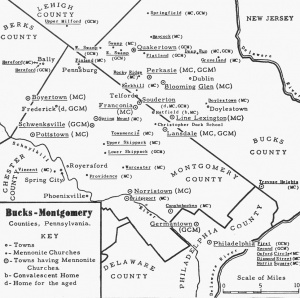Difference between revisions of "Bucks County (Pennsylvania, USA)"
| [unchecked revision] | [checked revision] |
GameoAdmin (talk | contribs) (CSV import - 20130816) |
SamSteiner (talk | contribs) |
||
| (2 intermediate revisions by one other user not shown) | |||
| Line 1: | Line 1: | ||
| − | + | [[File:ME1_462.jpg|300px|thumb|right|''Mennonites in Bucks-Montgomery counties, | |
Pennsylvania in 1950. | Pennsylvania in 1950. | ||
| − | Source: Mennonite Encyclopedia, v. 1, p. 462 . | + | Source: Mennonite Encyclopedia, v. 1, p. 462. '']] Bucks County, located in southeastern [[Pennsylvania (USA)|Pennsylvania]] along the Delaware River, was one of the three original counties in the province. William Penn named it after Buckinghamshire of England. His residence, Pennsbury Manor, now restored, is located in southern Bucks County. Chief cities in the Mennonite northern half of the county are [[Doylestown (Pennsylvania, USA)|Doylestown]] and [[Quakertown (Pennsylvania, USA)|Quakertown]]. The first settlers were English Quakers. German settlers came into Bucks County from the expanding settlements of [[Montgomery County (Pennsylvania, USA)|Montgomery County]] in the west. The earliest Mennonite settlement in Bucks County was probably in Bedminster Township which was created in 1742. Its first meetinghouse was built about 1746. |
| − | |||
| − | '']] Bucks County, located in southeastern [[Pennsylvania (USA)|Pennsylvania]] along the Delaware River, was one of the three original counties in the province. William Penn named it after Buckinghamshire of England. His residence, Pennsbury Manor, now restored, is located in southern Bucks County. Chief cities in the Mennonite northern half of the county are [[Doylestown (Pennsylvania, USA)|Doylestown]] and [[Quakertown (Pennsylvania, USA)|Quakertown]]. The first settlers were English Quakers. German settlers came into Bucks County from the expanding settlements of [[Montgomery County (Pennsylvania, USA)|Montgomery County]] in the west. The earliest Mennonite settlement in Bucks County was probably in Bedminster Township which was created in 1742. Its first meetinghouse was built about 1746. | ||
The Mennonite congregations in Bucks County totaled about 2,700 baptized members in 1950, about two thirds of whom belong to the [[Franconia Mennonite Conference (Mennonite Church USA)|Franconia Mennonite Conference]], with 10 organized congregations, and one third to the [[Eastern District Conference (Mennonite Church USA)|Eastern District Conference]], with 7 congregations. | The Mennonite congregations in Bucks County totaled about 2,700 baptized members in 1950, about two thirds of whom belong to the [[Franconia Mennonite Conference (Mennonite Church USA)|Franconia Mennonite Conference]], with 10 organized congregations, and one third to the [[Eastern District Conference (Mennonite Church USA)|Eastern District Conference]], with 7 congregations. | ||
| Line 12: | Line 10: | ||
The Mennonite settlement extends from central Bucks County north into [[Lehigh County (Pennsylvania, USA)|Lehigh]] and [[Berks County (Pennsylvania, USA)|Berks]] counties and west into Montgomery County. | The Mennonite settlement extends from central Bucks County north into [[Lehigh County (Pennsylvania, USA)|Lehigh]] and [[Berks County (Pennsylvania, USA)|Berks]] counties and west into Montgomery County. | ||
| − | |||
| − | |||
{{GAMEO_footer|hp=Vol. 1, p. 461|date=1953|a1_last=Leatherman|a1_first=Quintus|a2_last= |a2_first= }} | {{GAMEO_footer|hp=Vol. 1, p. 461|date=1953|a1_last=Leatherman|a1_first=Quintus|a2_last= |a2_first= }} | ||
| + | [[Category:Places]] | ||
| + | [[Category:Counties/Regional Governments]] | ||
| + | [[Category:Counties/Regional Governments in Pennsylvania]] | ||
| + | [[Category:Counties/Regional Governments in the United States]] | ||
Latest revision as of 18:52, 5 March 2021
Bucks County, located in southeastern Pennsylvania along the Delaware River, was one of the three original counties in the province. William Penn named it after Buckinghamshire of England. His residence, Pennsbury Manor, now restored, is located in southern Bucks County. Chief cities in the Mennonite northern half of the county are Doylestown and Quakertown. The first settlers were English Quakers. German settlers came into Bucks County from the expanding settlements of Montgomery County in the west. The earliest Mennonite settlement in Bucks County was probably in Bedminster Township which was created in 1742. Its first meetinghouse was built about 1746.
The Mennonite congregations in Bucks County totaled about 2,700 baptized members in 1950, about two thirds of whom belong to the Franconia Mennonite Conference, with 10 organized congregations, and one third to the Eastern District Conference, with 7 congregations.
It was at the Swamp Church near Quakertown, Pennsylvania, where the historic 1847 division occurred in the Franconia Conference. The more progressive group, led by John H. Oberholtzer, later became the Eastern District Conference of the General Conference Mennonite Church. In 1950 there was also one congregation of the Mennonite Brethren in Christ in Bucks County, at Quakertown.
The Mennonite settlement extends from central Bucks County north into Lehigh and Berks counties and west into Montgomery County.
| Author(s) | Quintus Leatherman |
|---|---|
| Date Published | 1953 |
Cite This Article
MLA style
Leatherman, Quintus. "Bucks County (Pennsylvania, USA)." Global Anabaptist Mennonite Encyclopedia Online. 1953. Web. 22 Nov 2024. https://gameo.org/index.php?title=Bucks_County_(Pennsylvania,_USA)&oldid=170475.
APA style
Leatherman, Quintus. (1953). Bucks County (Pennsylvania, USA). Global Anabaptist Mennonite Encyclopedia Online. Retrieved 22 November 2024, from https://gameo.org/index.php?title=Bucks_County_(Pennsylvania,_USA)&oldid=170475.
Adapted by permission of Herald Press, Harrisonburg, Virginia, from Mennonite Encyclopedia, Vol. 1, p. 461. All rights reserved.
©1996-2024 by the Global Anabaptist Mennonite Encyclopedia Online. All rights reserved.

